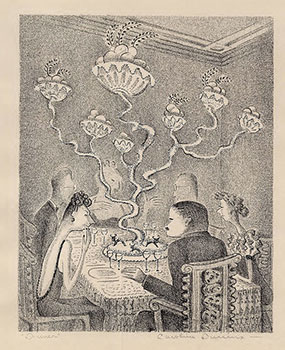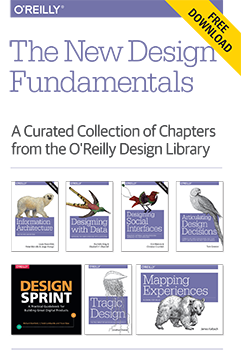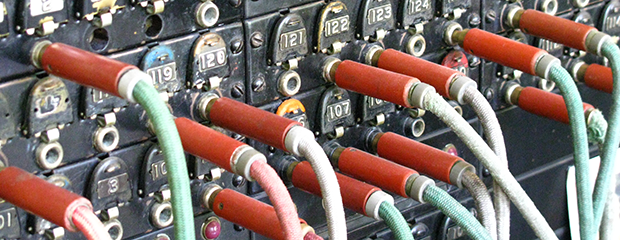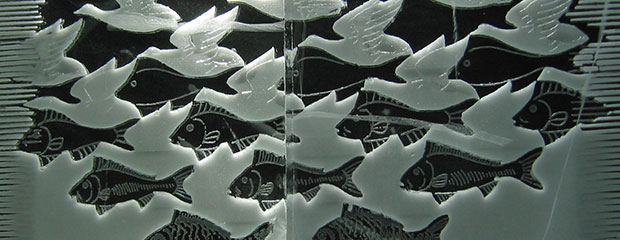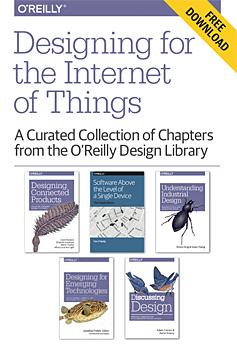Mary Treseler
Privacy and security are every UX designer’s responsibility
The O’Reilly Design Podcast: Ame Elliott on UX privacy and security, and how architecture informs her design work.
Subscribe to the O’Reilly Design Podcast, our podcast exploring how experience design — and experience designers — are shaping business, the Internet of Things, and other domains.
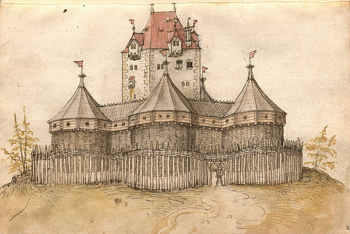 In this week’s Design Podcast episode, I sit down with Ame Elliott, design director at Simply Secure. She addresses the relationship between — and challenges of — privacy and security, noting “there’s plenty of tough to go around.”
In this week’s Design Podcast episode, I sit down with Ame Elliott, design director at Simply Secure. She addresses the relationship between — and challenges of — privacy and security, noting “there’s plenty of tough to go around.”
Elliott also talks about how her experience of attending architecture school informs her design work, and looks at the responsibility of designers to create for a greater good.
Here are a few highlights from our chat:
I think architecture can be a wonderful form of a design-inspired liberal arts education. If you look at places like Italy, I think there are certainly ways that you can go to architecture school and not be set up to practice architecture. The studio experience of actually being together in this communal space, working on a drafting table, making things visual — it’s so foundational to a lot of the things that are called ‘design thinking’ today.
Privacy or confidentiality is one technical goal of security. There are other technical goals of security: integrity, non-reputability, and other kinds of things. Coming at this from a human-centered design perspective … I care about what end users experience, and privacy feels like the quality people are looking for in an interaction.
Designing at Nasdaq
The O’Reilly Design Podcast: Aaron Irizarry on getting and keeping a seat at the table.
Subscribe to the O’Reilly Design Podcast to explore how experience design — and experience designers — are shaping business, the Internet of Things, and other domains.
Welcome to the inaugural episode of our newly launched O’Reilly Design Podcast. In this podcast episode, I chat with Aaron Irizarry. Irizarry is the director of UX for product design at Nasdaq, co-author of “Discussing Design” with Adam Connor, and a member of the program committee for O’Reilly’s Design Conference.
Design at Nasdaq: A growing team
I first noted Nasdaq’s commitment to design when talking to Irizarry about his book and the design conference hosted by Nasdaq that Irizarry helps develop:
It’s interesting to see an organization that didn’t have a product design team as of, what — 2011, I believe. To see the need for that, bring someone in, hire them to establish a team (which is my boss, Chris), and then see just the transition and the growth within the company, and how they embraced product design. We had to work a lot, and really educate and pitch in the beginning, explain to them the value of certain aspects of the job we were doing, whether that was research, usability, testing, why we were wanting to do more design of browser and rapid prototyping, and things like that.
…
We believe we’re helping structure and build, and I think we still have work to do as a design-led organization. We recently did our Pro/Design conference in New York. Our opening speaker was the president of Nasdaq, and to hear her reference the design team’s research, and to be in marketing meetings, and discussing the personas that we created, and to hear the president of Nasdaq speak about these kind of artifacts and items that we feel are crucial to design and the design process, it was a mark for us like, ‘We’re really starting to make a mark here. We’re starting to show the value of what these things are,’ not just because we want design, but we believe that this approach to design is going to be really good for the product, and in the end, good for the business. Read more…
Designing with best practices, principles, and interaction patterns
It's important for designers to see emerging standards and understand how one experience affects expectations for the next.
Download a free copy of “The New Design Fundamentals” ebook, a curated collection of chapters from our Design library. Note: this post is an excerpt from “Designing Social Interfaces,” by Christian Crumlish and Erin Malone, which is included in the curated collection.
With the growing expectation of seamless experiences, it is important for designers to see the emerging standards and to understand how one experience of a site and its interactions affects expectations for the next site. By working with standard and emerging best practices, principles, and interaction patterns, the designer takes some of the burden of understanding how the application works off the user, who then can focus on the unique properties of the social experience she is building.To start, we do define these three things differently. They live along a continuum, from prescriptive (rules you should follow) to assumptions (a basic generalization that is accepted as true) to process (ways to approach thinking about these concepts).
Principle: A basic truth, law, or assumption
Principles are basic assumptions that have been accepted as true. In interaction design, they can lend guidance for how to approach a design problem, and have been shown to be generally true with respect to a known user experience problem or a set of accepted truths.
For example: be learnable — create systems that are easily learned and provide cues for users to predict how things work from one area to another.
Principles don’t prescribe the solution, though, like an interaction pattern does; instead, they support the rationale behind an interaction design pattern or set of best practices. Read more…
The O’Reilly Design Conference: Design the Future — CFP is now open
The conference will take place January 20-22, 2016, in San Francisco, and we want to hear from you.
Submit a proposal to speak at The O’Reilly Design Conference: Design the Future, our new design conference looking at the convergence of design, programming, and business.
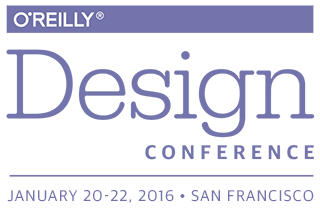 Last year, I had a conversation with Tim O’Reilly about the emergence of design in unexpected places — in the data community, in the programming community, and in the business community. Design has become increasingly important as technology and bandwidth become commoditized. Our conversation initiated what would become a new program for us here at O’Reilly, and our relatively recent focus on design has reached a milestone: I’m thrilled to announce the first O’Reilly Design Conference: Design the Future, coming to San Francisco in January 2016. Read more…
Last year, I had a conversation with Tim O’Reilly about the emergence of design in unexpected places — in the data community, in the programming community, and in the business community. Design has become increasingly important as technology and bandwidth become commoditized. Our conversation initiated what would become a new program for us here at O’Reilly, and our relatively recent focus on design has reached a milestone: I’m thrilled to announce the first O’Reilly Design Conference: Design the Future, coming to San Francisco in January 2016. Read more…
Designers as data scientists
Data science isn't only the purview of analysts and statisticians; it should be part of a designer's skill set as well.
Download a free copy of “The New Design Fundamentals” ebook, a curated collection of chapters from our Design library. Note: this post is an excerpt from “Designing with Data,” by Rochelle King and Elizabeth F. Churchill, which is included in the curated collection.
It might feel like using data is big news now, but the truth is that we’ve been using data for a long time. For the past 20 years, we’ve been moving and replicating more and more experiences that we used to have in the physical world into the digital world. Sharing photos, having conversations, duties that we used to perform in our daily work have all become digital. We could probably have a separate discussion as to how much the migration from the physical “real” world to the digital world has benefitted or been detrimental to our society, but you can’t deny that it’s happening and only continues to accelerate at a breakneck pace.Let’s take a look at what it means for these experiences to be moving from the physical to the digital. Not too long ago, the primary way that you shared photos with someone was that you would have to have used your camera to take a photo at an event. When your roll of film was done, you’d take that film to the local store where you would drop it off for processing. A few days or a week later, you would need to pick up your developed photos, and that would be the first time you’d be able to evaluate how well the photos that you took many days prior actually turned out. Then, maybe when someone was at your house, you’d pull out those photos and narrate what each photo was about. If you were going to really share those photos with someone else, you’d maybe order duplicates and then put them in an envelope to mail to them — and a few days later, your friend would get your photos as well. If you were working at a company like Kodak that had a vested interest in getting people to use your film, processing paper, or cameras, then there are so many steps and parts of the experience that I just described which are completely out of your control. You also have almost no way to collect insight into your customers’ behaviors and actions along the process. Read more…
Toward a damned good information architecture
An IA model informed by an "information ecology" composed of users, content, and context.
Download a free copy of “The New Design Fundamentals” ebook, a curated collection of chapters from our Design library. Note: this post is an excerpt from “Information Architecture,” 4th Edition, by Louis Rosenfeld, Peter Morville, and Jorge Arango, which is included in the curated collection.
Users. Content. Context. You’ll hear these three words again and again throughout this book. They form the basis of our model for practicing effective information architecture design. Underlying this model is a recognition that you can’t design useful information architectures in a vacuum. An architect can’t huddle in a dark room with a bunch of content, organize it, and emerge with a grand solution. It simply won’t hold up against the light of day.Websites, intranets, apps, and other information environments are not lifeless, static constructs. Rather, there is a dynamic, organic nature to both the information systems and the broader contexts in which they exist. This is not the old world of yellowing cards in a library card catalog. We’re talking complex, adaptive systems with emergent qualities. We’re talking rich streams of information flowing within and beyond the borders of departments, business units, institutions, and countries. We’re talking messiness and mistakes, trial and error, survival of the fittest.
We use the concept of an “information ecology” composed of users, content, and context to address the complex dependencies that exist. And we draw upon our trusty Venn diagram (see Figure 2–6) to help people visualize and understand these relationships. The three circles illustrate the interdependent nature of users, content, and context within a complex, adaptive information ecology. Read more…
Designing for ecosystems: Making meaningful IoT products and services
Mike Kuniavsky on PARC’s work on IoT and the mindset shift the IoT will require.
Attend O’Reilly’s Solid Conference, June 23–25, in San Francisco. Mike Kuniavsky will be speaking at Solid, O’Reilly’s conference on the collision of software and hardware, and the Internet of Things.
The emergence of the Internet of Things has prompted the production of thousands of new connected devices. More challenging and interesting in many ways, though, is how to embed intelligence into existing products and services. Corporations are trying to wrap their collective minds around the possibilities the IoT presents, but many don’t have the internal expertise to make sense of the space. Companies like Palo Alto Research Center Incorporated (PARC) are helping these organizations with the transition to the IoT. I recently chatted with Mike Kuniavsky of PARC. Kuniavsky is a user experience designer, researcher, and author. He is a member of the Innovation Services Group at PARC, a strategy consulting team within the research organization, formerly known as Xerox PARC.
Bringing the IoT to Fortune 50 companies
PARC has been around since 1970 and has contributed to the evolution of computing, including laser printing, graphic user interface, and the Ethernet. It should be no surprise that they are working on the next generation of computing with the IoT. Kuniavsky explains a bit more about what he and the team are working on:
The Innovation Services Group is essentially PARC’s consulting arm. Of course Xerox is still PARC’s biggest client because it’s our parent company, but it is no longer our group’s biggest client, for sure. We mostly work with Fortune 50 companies. A lot of what we do is essentially reduce the risk of adopting novel technologies through the use of user experience design and ethnography, and an innovation strategy. These days, a lot of that is in the form of looking at things that are broadly in the Internet of Things. Part of that is because that’s where my expertise is; I’ve been playing with connected hardware for 25 years. Part of it is because that’s where there’s a lot of interest. It’s gotten me to really think about the entire ecosystem that the Internet of Things is. It’s not just hooking up a sensor to the Internet and sticking it somewhere in your house. It’s a much larger ecosystem, from my perspective. That’s what we’ve been exploring a lot because that’s what’s interesting to our customers, is understanding not just how this piece of cheap commodity hardware, which can be replicated very easily by any one of their competitors, is going to create an advantage for them, but how this one specific piece of hardware is going to create an ecosystem that is going to be very competitive and is going to create significant value. Read more…
How to conduct a Design Sprint
Design Sprints bring clarity to your roadmap to kickstart and obtain initial validation for product design work.
Download a free copy of “The New Design Fundamentals” ebook, a curated collection of chapters from our Design library. Note: this post is an excerpt from “Design Sprint,” by Richard Banfield, C. Todd Lombardo, and Trace Wax, which is included in the curated collection.
A Design Sprint is a flexible product design framework that serves to maximize the chances of making something people want. It is an intense effort conducted by a small team, where the results will set the direction for a product or service.The Design Sprint consists of five discrete phases:
- Understand (review background and user insights)
- Diverge (brainstorm what’s possible)
- Converge (rank solutions, pick one)
- Prototype (create a minimum viable concept)
- Test (validate with users)
A Design Sprint reduces the risk of downstream mistakes and generates vision-led goals the team can use to measure their success. For the purpose of this book, we’ll focus on digital products since our direct experience lies in that arena, though the Design Sprint has roots in gaming and architecture, and many industries have employed them successfully. Read more…
Information architecture’s role in UX design
Jorge Arango discusses the state of IA and the importance of designers' understanding of context and perspective.
Jorge Arango is an information architect who has been practicing in the user experience field for more than 20 years. Before moving to San Francisco about a year ago, his work was conducted in Panama. Last year, he moved to the San Francisco Bay Area and now works as a partner at Futuredraft, a digital product design consultancy. Arango brings a unique perspective, given his background in architecture prior to becoming an information architect. He is currently finishing up the 4th Edition of Information Architecture — lovingly referred to as “The Polar Bear book” — with Louis Rosenfeld and Peter Morville.
IA’s broadening appeal
Information architecture (IA) has always been an important part of user experience design, though not always acknowledged as such. With the emergence of social, IoT, and mobile, we have watched IA taking on a more dominant role in product development. Arango talked a bit about the evolution:
I’m surprised by how many people actually know about it because I think, frankly, a lot of what we do is fairly esoteric. I’m not just talking about information architects. I’m talking about those of us in technology in general, and in the design professions. On having moved to California, I have this open question in my mind: how much do people know about this stuff here? Is it something that is talked about? I’ve been pleasantly surprised by interactions with clients and prospects … There seems to be a realization. In many cases, they probably don’t know to call it ‘information architecture’ per se, but there seems to be a realization that stuff needs to be easy to find and easy to understand.
Smell and taste: New frontiers for experience design
Designers need not start from scratch as they wrestle with orchestrating experiences that span digital and physical.
Download a free copy of Designing for the Internet of Things, a curated collection of chapters from the O’Reilly Design library. This post is an excerpt from Understanding Industrial Design, by Simon King and Kuen Chang, one of the books included in the curated collection.
Two of our richest senses, smell and taste, are not often associated with design. However, the creation of objects that support these senses is an ancient practice, embodied best by the tea set, where rituals of assembly and service lead to hints of the aroma. Holding the tea cup warms your hand without burning it, and the slow sipping of the tea forms a communal bond with other participants. Outside of classic and common serving items, designers today are increasingly finding new ways to collaborate with chefs and food companies to design with smell and taste in mind, forging a new frontier for sensorial design.
Martin Kastner is the founder and principal of Crucial Detail, a studio in Chicago that specializes in custom pieces to support unique culinary experiences. Martin is best known for his work designing serviceware concepts for Alinea, the 3-star Michelin restaurant founded by chef Grant Achatz. That collaboration has extended to other restaurants owned by Achatz, including The Aviary, a cocktail bar that prides itself on serving drinks with the same level of attention as a fine dinner.
At The Aviary, one of the most popular creations by Crucial Detail is the Porthole Infuser, a round vessel that presents the ingredients of a patron’s cocktail between two flat panes of glass, emphasizing the transformative action of the steeping process and building anticipation for the cocktail’s taste. The Porthole Infuser takes a part of the preparation process that is normally hidden and brings it directly to the person’s table, providing time for the drinker to contemplate the ingredients on display, creating a mental checklist for their tongue to seek out when they take their first sip.The popularity of the Porthole Infuser at the Aviary led Kastner to create a Kickstarter campaign to fund the additional design and manufacturing required to release it as a commercial product. Support for the project was dramatic, achieving 25 times more funding than originally asked. This backing set the course for a redesign that allowed the infuser to be manufactured at scale and sold for $100, down from the several hundred dollars that each custom constructed version for The Aviary cost.
The Porthole Infuser is marketed as more than a cocktail tool, working equally well to support the smell and taste of oils, teas, or any other infusion recipe. It’s an example of how designers can enhance the dining experience, not by crafting the smell or taste of the food itself, but working in collaboration with a chef to heighten our awareness of those senses. Read more…
 Mary Treseler is Director of Strategic Content at O'Reilly Media, Inc. She acquires, curates, and edits design content, when not writing about it herself. Her experience with design-related topics includes editing "Lean UX" and "Designing Interfaces" as well as launching "The Lean Series" with Eric Ries. Mary has more than 20 years of experience working in technology publishing; her introduction to the design discipline began in 1993 with Jakob Nielsen's "Usability Engineering." A Boston native, Mary lives by the ocean in South Dartmouth, MA.
Mary Treseler is Director of Strategic Content at O'Reilly Media, Inc. She acquires, curates, and edits design content, when not writing about it herself. Her experience with design-related topics includes editing "Lean UX" and "Designing Interfaces" as well as launching "The Lean Series" with Eric Ries. Mary has more than 20 years of experience working in technology publishing; her introduction to the design discipline began in 1993 with Jakob Nielsen's "Usability Engineering." A Boston native, Mary lives by the ocean in South Dartmouth, MA.
